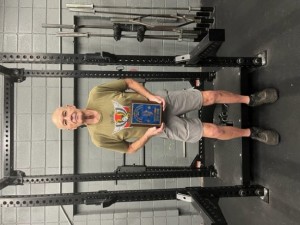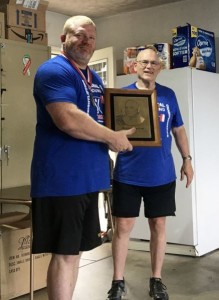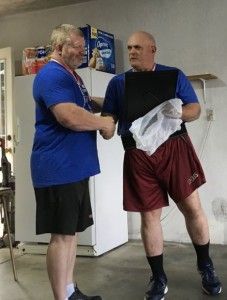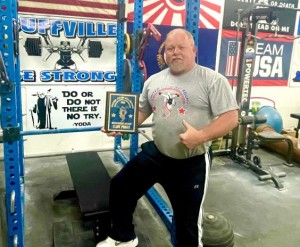By Jarrod Fobes
Over a period of about 10 years, I competed frequently in a variety of combat sports. I mostly competed in judo and no-gi grappling, but I also fought in mixed-martial arts, kickboxing, SAMBO, and Brazilian jiu-jitsu. Most of my experience was at the regional level, but I had some experience at national and international competitions as well.
During this time, I had the opportunity to compete against and train with a wide variety of athletes, many of whom came from a background in strength sports. I thought some members might be interested in my impression of different approaches to strength training, and how they apply to combat sports.
For perspective, I could probably be categorized as a recreational lifter during this period. Most of my strength training consisted of bodyweight exercises and so-called functional strength training; lifting with sandbags, railroad ties, slosh bars (long sections of PVC pipe, capped and partially filled with water or sand); anything heavy and/or awkward. I also did a lot of plyometrics, as I was somewhat obsessed with speed. However, no one would have been impressed by my gym lifts. My bench press at that time was never much more than my bodyweight, and my back did not tolerate any kind of deadlifting or most types of squatting while I was training martial arts intensely. I worked quite a few manual labor jobs, and was usually regarded as a strong guy at the job site. But you sure couldn’t tell it from my performance in the weight room. So the following assessment comes from a guy who was in shape, but very much outside of the serious strength training world.
Olympic lifters
I started to run into these guys more as Crossfit grew more popular. They were always generally fit, very coordinated, and usually had great fighting technique. But I never really felt overpowered by any of them. Most combat sports, but especially judo, require powerful flexion in the core and especially the hips, and the Olympic lifts focus much more on extension movements. Famous powerlifting coach Louie Simmons once wrote that he was not a big fan of Olympic lifting as a means of strength training for other sports, and I tend to agree. What’s more, it seemed like the Olympic guys were always injured. Olympic lifting in and of itself is a beautiful sport, but the highly technical nature of the lifts coupled with the near total focus on extension movements makes it one of the least practical disciplines I encountered, at least in terms of developing fighting strength.
Bodybuilders
It is highly debatable whether or not bodybuilding can be considered a strength sport since it focuses 100% on the aesthetics of the lifter, rather than on lifting performance. A trainer I once worked with said, “bodybuilding is for people who aren’t good at real sports,” and to an extent, I used to agree. But these guys were actually a surprise to me. I learned pretty fast that if someone looked strong, they probably were. The bodybuilders I encountered were not especially fast, but they weren’t slow either. The most notable thing about them was their muscle endurance. As long as they had paid attention to their conditioning, these guys were just as strong at the end of a period or round as they were at the beginning. Also, they made tremendous strength gains very quickly once they shifted their lifting style.
Powerlifters
One of my old training partners held a powerlifting record at Kansas State University, where he had put up a 1000lbs squat. He weighed around 300lbs, and sparring him was like fighting a polar bear…for about 60 seconds. After that, he was gassed out and could be handled fairly easily by anyone with good technique. I found this to be consistent with all of the heavyweight and super heavyweight powerlifters that I encountered. The key was always to weather the initial storm, let them tire out, then begin cautiously going on the offensive. Caution was essential because they could sometimes muster another burst of strength before the end of period.
The sub-heavyweights were another matter. Any of these guys that were about 205lbs or under were really, really difficult to deal with. They tended to be strong on all the major athletic attributes: they were strong, fast, coordinated, and well-conditioned. If they happened to be short, they were my least favorite people to deal with in a grappling situation, since their low center of gravity made them difficult to take down, and their short, powerful limbs didn’t offer much leverage when working for arm or leg locks. Striking is another matter, since whoever has a longer reach has a significant advantage.
Crossfitter
Personally, I am not a huge fan of Crossfit for a number of reasons, but the handlful of combat athletes I met who also trained in Crossfit were in all around good shape. Some felt stronger than me, most did not. All were well-conditioned, but I can’t remember one who was as fast or faster than me. Like the Olympic lifters, they tended to be injured a lot. I really didn’t run into too many of these guys; I think the intensity of Crossfit makes it difficult to combine with competitive combat sports training, plus I have seen a lot of Crossfit programming that is unsafe by itself. I was a trainer at an unofficial Crossfit gym for a while, where we would receive a workout of the day (WOD) from our Crossfit affiliate, then run our clients through it. I do not remember a single WOD that I did not modify for safety reasons. If another trainer ran the class and did not make modifications, injuries were very common. One WOD called for a ridiculous 250 box jumps, which led to a client tearing her meniscus. So most Crossfitters that try combat sports end up ditching one in favor of the other. The two injury rates combined are just too much.
Laborers
Hard work is obviously not a strength sport, but these guys deserve mention. I have trained with farmers, masons, and concrete workers who did not do much strength training outside of their job, and they were always very strong. A mechanic who’s been turning wrenches for a couple of decades will have some impressive grip strength, which can really slow you down, especially in a jacket wrestling style like judo or SAMBO. These guys were also the most surprising. They may look a little soft, or thin, but then once you tie up with them you can immediately feel that you are in for a fight. While someone who looks strong probably is, someone who doesn’t look strong might surprise you.



